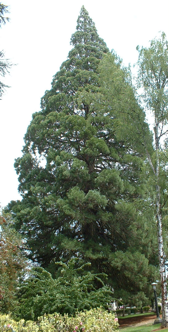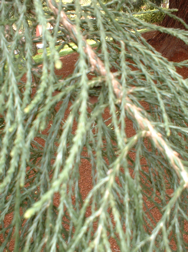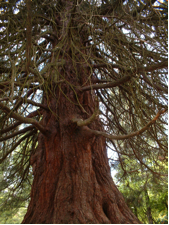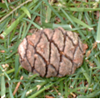The Giant Sequoia
Tag Number: 652
Scientific Name: Sequoiadendron giganteum
Its name is derived from Sequoyah, who dedicated his life to creating a Native American alphabet and teaching it to others
 |
 |
 |
 |
 |
Common Names
- California Bigtree
- Giant Sequoia
- Gigantea
- Mammoth-tree
- Sierra Redwood
Habitat
Grows naturally in 26 remote areas in the Sierra Nevada Mountains of California. Often planted throughout the Northwest due to its magnificent size.
Morphology
Sports cones the size of chicken eggs with ruse-shaped (trapezoidal) scales. Its thick bark can measure up to 2 feet in depth.
Phenology
The Giant Sequoia produces cones between November and February; it takes at least 3 years for them to release their seeds, and it takes 3000 seeds to measure an ounce.
History
Immigrant journals reveal that the first Giant Sequoia they came upon was in Calaveras North Grove; they harvested it and used it as a dance floor that held 30 couples. Well-sized Sequoia stumps formed both the foundation and flooring for their homes. In the same grove, a man rode his horse with perfect posture through a hollow log that is now deemed the Father of the Forest. This comes as no surprise when one discovers the 2 extant species of Sequoia are the tallest, widest trees in the word. The Giant Sequoias were originally coined Mammoth Trees. This title was inorrect if it was in reference to their antiquity, nonetheless they can live to be an impressive 3200 years old. If it was in reference to their enormity, the settlers that wanted to, and often did, believe every fable they heard of this awesome tree would be pleased to discover the tree's roots can grow to be lengthier than the height of the tree. The tannic acid in their sap can heal the trees, act as a fire repellent, and protect the trees from parasites. Tannic acid is used in today's fire extinguishers and applied medicinally on human burns. When the trees are relatively in their adolescent years, they maintain a conical shape and have limbs near the ground that swoop downward to keep them from toppling to their death when faced with winter snowfalls higher than they are. As they grow more ancient, they no longer need the lower limbs. Thus, their lower branches are well beyond human reach during the second century of their growth. Although their lumber is not as fine a quality as that of trees used by our current lumber industries, the notion of having so much wood available to them sent quite a thrill into early settlers. To protect the trees from extinction, national parks were established. There were no forest rangers to enforce the trees' protection, so President Theodore Roosevelt ordered a cavalry to guard the trees. They stabled their horses in a log called the Fallen Monarch Tree in what is now part of King's Canyon National Park and may have saved these magnificent giants from death.


